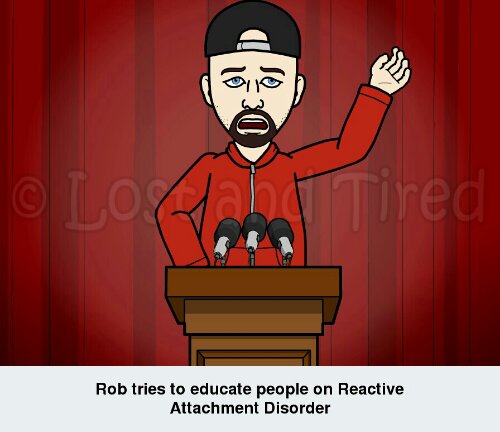I know that I talk about Gavin and Reactive Attachment Disorder on this blog but it’s clear that many people don’t understand.. Believe me, I get it. This isn’t something easy to digest.
I thought I would share some of the clinical information about Reactive Attachment Disorder that’s has helped me to better understand what’s going on.
I’ve share a ton of personal experience but perhaps the clinical information can help put things into perspective..

This is courtesy of the Mayo Clinic. You can find this information at the following link. All rights and credit belong to the amazing Mayo Clinic. Click here.
Symptoms
Reactive attachment disorder begins before age 5. Signs and symptoms of the disorder may begin when the child is still an infant.
Signs and symptoms in babies may include:
Withdrawn, sad and listless appearance
Failure to smile
Lack of the normal tendency to follow others in the room with the eyes
Failure to reach out when picked up
No interest in playing peekaboo or other interactive games
No interest in playing with toys
Engaging in self-soothing behavior, such as rocking or self-stroking
Calm when left alone
Signs and symptoms in toddlers, older children and adolescents may include:Withdrawing from others
Avoiding or dismissing comforting comments or gestures
Acting aggressively toward peers
Watching others closely but not engaging in social interaction
Failing to ask for support or assistance
Obvious and consistent awkwardness or discomfort
Masking feelings of anger or distress
Alcohol or drug abuse in adolescents
As children with reactive attachment disorder grow older, they may develop either inhibited or disinhibited behavior patterns. While some children have signs and symptoms of just one type of behavior, many exhibit both types.Inhibited behavior. Children with inhibited behavior shun relationships and attachments to virtually everyone. This may happen when a baby never has the chance to develop an attachment to any caregiver.
Disinhibited behavior. Children with disinhibited behavior seek attention from virtually everyone, including strangers. This may happen when a baby has multiple caregivers or frequent changes in caregivers. Children with this type of reactive attachment disorder may frequently ask for help doing tasks, have inappropriately childish behavior or appear anxious.
There’s little research on signs and symptoms of reactive attachment disorder beyond early childhood. It may lead to controlling, aggressive or delinquent behaviors, trouble relating to peers, and other problems. While treatment can help children and adults cope with reactive attachment disorder, the changes that occur during early childhood are permanent and the disorder is a lifelong challenge.When to see a doctor
If you think your child may have reactive attachment disorder, see a doctor. You may start by visiting your family doctor. However, if your child likely has reactive attachment disorder or another mental health problem, you’ll need to see a doctor who specializes in the diagnosis and treatment of mental illness (psychiatrist) for a complete evaluation.Consider getting an evaluation if your baby or child:
Prefers not to be held
Usually likes to play alone
Doesn’t seek out physical contact
Avoids you
Will readily go to strangers
Seems uninterested in youCauses
To feel safe and develop trust, infants and young children need a stable, caring environment. Their basic emotional and physical needs must be consistently met. For instance, when a baby cries, his or her need for a meal or a diaper must be met with a shared emotional exchange that may include eye contact, smiling and caressing.
A child whose needs are ignored or met with emotionally or physically abusive responses from caregivers comes to expect rejection or hostility. The child then becomes distrustful and learns to avoid social contact. Emotional interactions between babies and caregivers may affect development in the brain, leading to attachment problems and affecting personality and relationships throughout life.
Most children are naturally resilient, and even those who’ve been neglected, lived in orphanages or had multiple caregivers can develop healthy relationships and strong bonds. It’s not clear why some babies and children develop reactive attachment disorder and others don’t.
Risk Factors
Reactive attachment disorder is rare. However, there are no accurate statistics on how many babies and children have the condition. Reactive attachment disorder begins before age 5, usually starting in infancy.
Factors that may increase the chance of developing reactive attachment disorder include:
Living in an orphanage
Institutional care
Frequent changes in foster care or caregivers
Inexperienced parents
Extreme neglect
Prolonged hospitalization
Extreme poverty
Physical, sexual or emotional abuse
Forced removal from a neglectful or abusive home
Postpartum depression in the baby’s mother
Parents who have a mental illness, anger management problems, or drug or alcohol abuseComplications
Complications of reactive attachment disorder can continue into adulthood and can include:
Delayed learning or physical growth
Poor self-esteem
Delinquent or antisocial behavior
Relationship problems
Temper or anger problems
Eating problems, which can lead to malnutrition in severe cases
Depression
Anxiety
Academic problems
Drug and alcohol addiction
Unemployment or frequent job changes
Inappropriate sexual behaviorTreatment
Treatment of reactive attachment disorder often involves a mix of psychological counseling, medications and education about the disorder. It may involve a team of medical and mental health providers with expertise in attachment disorders. Treatment usually includes both the baby or child and the parents or caregivers.
Goals of treatment are to help ensure that the baby or child has a safe and stable living situation and that he or she develops positive interactions with parents and caregivers. Treatment can also boost self-esteem and improve peer relationships.
There’s no standard treatment for reactive attachment disorder. However, it often includes:
Individual psychological counseling
Education of parents and caregivers about the condition
Parenting skills classes
Family therapy
Medication for other conditions that may be present, such as depression, anxiety or hyperactivity in a child or a parent
Special education services
Residential or inpatient treatment for children with more-serious problems or who put themselves or others at risk of harm
Other treatments for reactive attachment disorder that may be helpful include:Development of attachment between the child and the child’s therapist
Close, comforting physical contact
Managing reactive attachment disorder is a long-term challenge and can be quite demanding for parents and caregivers. You may want to consider seeking psychological counseling yourself or taking other steps to learn how to cope with the stress of having a child with reactive attachment disorder.Controversial and coercive techniques
The American Academy of Child and Adolescent Psychiatry, the American Psychiatric Association, and the American Professional Society on the Abuse of Children have all criticized dangerous and unproven treatment techniques for reactive attachment disorder. Controversial practices can be psychologically and physically damaging and have led to accidental deaths.Some unproven treatments for reactive attachment disorder include:
Re-parenting, rebirthing
Tightly wrapping, binding or holding children
Withholding food or water
Forcing a child to eat or drink
Yelling, tickling or pulling limbs, triggering anger that finally leads to submission
Beware of mental health providers who promote these methods. Some offer research as evidence to support their techniques, but none has been published in reputable medical or mental health journals.If you’re considering any kind of unconventional treatment, talk to your child’s psychiatrist first to make sure it’s legitimate and not harmful.
I hope this has given you a bit more perspective and perhaps some insight into my life. I know that it’s hard to imagine a child can do some of these things. I ask that you try to understand how difficult is is for a parent to have to come to grips with something like tbis
This site is managed almost exclusively from my Samsung Galaxy Note 3. Please forgive any typos as auto-correct HATES me. 😉
Follow @Lost_and_Tired
“Like” me on Facebook
Visit the My Autism Help Forums
To reach me via email, please Contact Me


i am so sorry this is happening to gavin and your family. i am educated enough thru your blog. it is BAD and has to be so hard to cope with
Bek Weller thank you. I’ve setup a support forum for RAD at the My #Autism Help Forums. http://www.myautismhelp.com hope to see you there
This is what my partners son is being investigated for. It’s a very difficult situation, to have such empathy for what the poor little munchkins are going through yet not being able to trust them is heartbreaking. Especially when there are other children involved you need to protect in the situation.
My heart goes out to you.
Michelle Kosmicki thanks. I only recently discovered bitstrip.. 🙂
Nice bitstrip ROb!